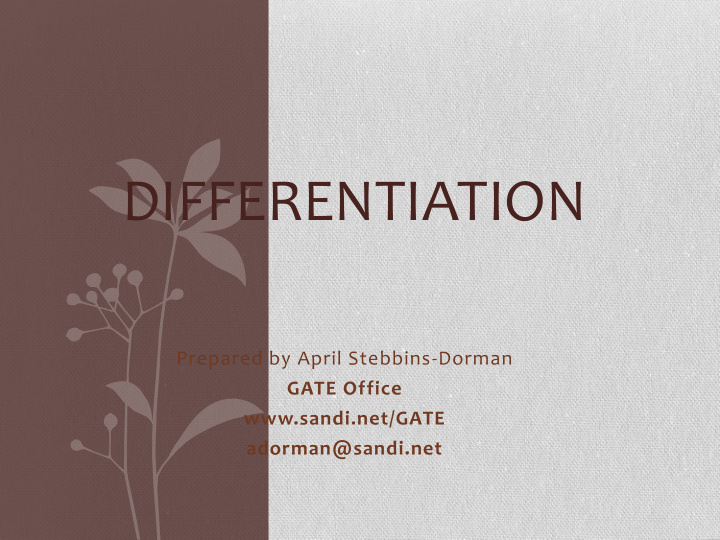



DIFFERENTIATION Prepared by April Stebbins-Dorman GATE Office www.sandi.net/GATE adorman@sandi.net
Differentiation To differentiate instruction is to recognize students’ varying background knowledge, readiness, language, preferences in learning and interests, and to react responsively . The intent of differentiated instruction is to maximize each student’s growth Note that differentiation relates and individual success by meeting more to addressing students’ each student where he or she is, and different phases of learning from assisting in the learning process. novice to capable to proficient Tracey Hall, Nicole Strangman, and Ann Meyer rather than merely providing different activities to different (groups of) students. John Hattie, Visible Learning for Teachers
Key Points • Differentiation is the foundation of effective teaching, from planning to instruction to student product. • Differentiation is proactive , based on the strengths, or readiness, of your learners. • Formative assessment is essential .
Reactive vs. Proactive Differentiation Reactive Differentiation Proactive Differentiation Is curriculum centered. Is learner centered. Is based on summative assessments or on what the Is based on preassessment and ongoing formative grade level expectation for readiness are (i.e. “all fifth assessment. graders should come to me knowing this”). Uses a strength model, “What can my students already do? How Uses a deficit model, “What are the students missing? can I build upon these strengths?” What problems will they have?” Is reactive, “My students don’t seem to be getting it. What can I Is proactive and planned, “My students have this piece, I can build adjust in this moment?” on that.” Tinkers with one-size-fits-all instruction. Makes small Is robust, consistent, reflective, and coherent-designed to address adjustments to fill perceived gaps. the range of learner readiness. Uses static small group instruction. Small groups are Uses a variety of flexible small groups. Members change determined by learner deficit, or labels, and members change continually based on student readiness, current task, etc. infrequently (i.e. ELL group, low group, “my 18s,” etc.) Students are all given the same resources. Materials are varied for differing instructional groups. Pacing is determined by scope and sequence. Pacing is adapted in response to student strengths/needs. Pacing is set to address the needs of the majority of learners. Time is viewed as a flexible resource. Pacing is Those who have mastered concepts are forced to wait for the based on learner readiness, acceleration for those rest of the class. Those who are having difficulty mastering a who have demonstrated mastery, additional time concept are forced to move ahead before they attain mastery with the promise that they will be reintroduced to the concept is given for those who need more practice. when the class “circles back” or in the next grade level when the concept is readdressed.
Differentiation is a teacher’s proactive response to learner strengths/needs shaped by mindset and guided by the general principals of differentiation and UDL Instruction that An environment Leading Assessment that responds to that encourages students and Quality informs teaching student variance and supports managing curriculum and learning and learning routines engagement Teachers can differentiate through Product/ Content Process Learning Environment Representation The information and How students take in The climate or tone of ideas students grapple and make sense of the the classroom and How students show with to reach learning content level of student what the know, goals engagement understand, and can do according to student’s Readiness Interests Learning Profile A student’s proximity to Passions, affinities, kinships Preferred approaches to specific learning goals that motivate learning learning Through a variety of instructional strategies, such as Learning/Interest Centers · RAFTs · Graphic Organizers · Scaffolded Reading/Writing · Tiered assignments · Learning Contracts · Menus · Tic-Tac-Toe · Complex Instruction · Independent projects · Expression/Representation Options · Small-Group Instruction Based on Tomlinson 2013
Vocabulary to Help in Planning Differentiation Differentiate Differentiate WHAT? HOW? Content Student readiness Process Student interest Product Student learning Learning profile environment Differentiate WHY? Access to learning Motivation, relevance, engagement Efficiency of learning Appropriate challenge Opportunity to express learning Tomlinson 2014
Human Digestive System 4 th grade Science by Howard Miller Students will (KUDs): (U) Understand the big idea. In this case, that (a) the human digestive system is an example of a system: a collection of two or more parts that act together to affect the whole thing, and (b) that each part is related to the others in some way. (K) Know the names and functions (jobs) of the major digestive system organs listed below, and include them in a song, story, or diagram: mouth; teeth; saliva; epiglottis; esophagus; stomach; samll intestine; villi; large intestine. (D) Demonstrate their understanding using the correct structure and function vocabulary to show how a piece of food moves through and provides food for the human body-from the time it enters the mouth to the time it leaves the body.
WHY? WHAT? HOW? • Product • Interest • To provide maximum opportunity to • Learning profile demonstrate learning • Engagement • Efficiency Small Group Kate Emma • Annotated diagram • Story • Song/skit • Girl eating a cookie • Family eating broccoli • Boy eating pizza • Worked alone • Worked alone • Student choice group of four Tomlinson 2014
3 Most Important Take Aways • Differentiation is the foundation of effective teaching, from planning to instruction to student product. • Differentiation is proactive , based on the strengths, or readiness, of your learners. • You can’t differentiate if you don’t know your students’ strengths. Formative assessment is essential .
References Meyer, A., Rose, D., Gordon, D. (2014). Universal Design for Learning: Theory and Practice. Wakefield, MA: CAST Professional Publishing. Novak, K. (2014). UDL NOW! Wakefield, MA: CAST Professional Publishing. Tomlinson, C. (2013). Assessment and Student Success in a Differentiated Classroom. Alexandria, VA: ASCD Publications. Tomlinson, C. (1999). The Differentiated Classroom: Responding to the Needs of All Learners. Alexandria, VA: ASCD Publications. Webinar: The Differentiated Classroom Revisited www.ascd.org Carol Ann Tomlinson (May 2014)
Recommend
More recommend